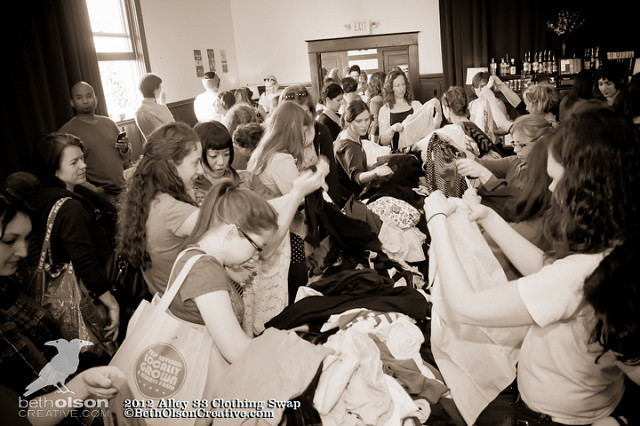Maybe you’ve heard about the environmental damage and human rights abuses caused by the fast fashion industry.
Maybe you’re feeling the need to tidy up your cluttered life. Or maybe you’re just looking for a way to feel better about the things that you buy on a day-to-day basis, knowing deep down that your choices do matter.
Whatever your reason, making the commitment to wearing a sustainable wardrobe is something that can be accomplished with simple steps each day.
Here are some ideas to get you started:
1. Use What You Have:
Before worrying that you have to fill your closet with all new ethically produced designer threads, remember that the first step toward sustainability is making choices that don’t require any raw materials to be developed, and don’t end with refuse in a landfill. Wear what you already have, and challenge yourself to confront all the weird emotional baggage that comes along with thinking that someone else’s opinion of how you look actually matters. (It really doesn’t.)
2. Borrow What You Need:
Single-use clothing is one of the reasons that 11 million tons of textile waste ends up in US landfills each year. Borrowing a suit for an interview or a dress and high heels for a party will save you money, and help lessen the amount of textile waste we produce as a nation. If your friends don’t have what you need, sites like Rent the Runway offer fashion you can rent as needed.
A clothing swap is a perfect way to pass on the articles of clothing you’re tired of, while stocking up on goodies that your friends never want to wear again.
It’s easy to host a swap: invite friends over for an evening of snacks and drinks, and have them bring a bag of unwanted clothing. While people are mingling, lay everything out, then invite everyone to peruse the goods, try things on and take with them any gems that they find. Make sure to have a full-length mirror handy.
At the end of the night, pack up any leftover garments and deliver them to a local women’s shelter. (Call ahead to confirm that your donation will be useful.)
4. Thrift to Your Heart’s Content:
If you’ve exhausted your use/borrow/swap options and simply must buy something, start with consignment stores, thrift stores and vintage shops. This is a great way to continue the lifecycle of a product.
There are also two semi-secret benefits to shopping secondhand: First, you’ll begin to notice that older clothing tends to be constructed with more durable materials and better craftsmanship. (There’s a reason that pair of old Levi’s has lasted so long.)
And second, because we live in a culture of impulse buys and rapidly changing trends, you will be amazed by how much brand-new, tags-still-attached stuff you can find in stores like the Salvation Army or Goodwill—all for a fraction of the price of buying new.
5. Make It Yourself:
Making it yourself comes next, because this one might involve purchasing some new supplies. However, the process of sewing your own clothing is a wonderful investment because it provides many benefits. There’s the creative fulfillment of design, the entertainment to be found in visiting local fabric stores and cruising the aisles of beautiful textiles, the satisfaction in learning how to read and follow a sewing pattern, the character-building aspect of committing to a project and achieving a goal, and finally, the pride of wearing something you made yourself.
Making your own clothes is also a great way to implement the first four steps outlined above—using materials you already have at hand, borrowing tools you don’t own, swapping a finished product for one made by another artisan and thrifting for cool vintage fabrics, buttons or trim.
6. Shop Small and Domestic:
In the end, you might just want to buy something, and that is totally okay. With this step, it’s important to start asking some questions, such as:
Who made this?
Where was it made?
Who ultimately benefits financially from my purchase?
And do I really need this thing?
Carefully consider the environmental, social and economic impact of your choice before making an investment.
Luckily, it’s getting easier and easier to find ethically produced items; here are a few sites that will make the search easier: The American Edit, The Americanologists and The Ethical Fashion Forum.
~
Author: Rachel Fernbach
Image: flickr/Beth Olson
Editor: Ashleigh Hitchcock












Read 0 comments and reply